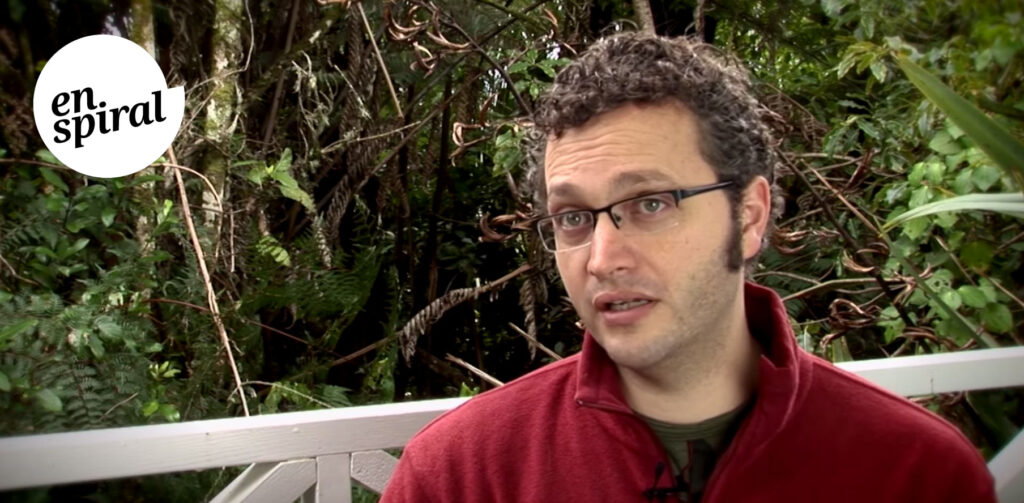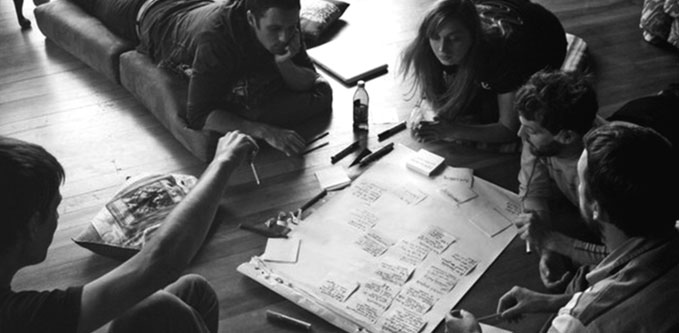By Jenn
This post is part of an ongoing series about collaboration in the workplace. We talk to individuals about their challenges, successes, and advice on how to collaborate more effectively.
Joshua Vial is an entrepreneur and founder of Enspiral, a global network of socially-minded individuals and enterprises. He is also the co-founder of Enspiral Craftworks, Enspiral Dev Academy, and a board member of Enspiral Foundation.
We talk to Joshua about transparency, the challenges of running a co-working space, and leadership dynamics in decentralized organizations.
Tell us about Enspiral and what you do there.
Enspiral is a collective of companies and individuals helping people work on stuff that matters. There are 15 or so ventures in the network, with a 50/50 split between professional services and building products. A big focus is network-based, decentralized organizing and using the tools of business to make the world a better place.
I work with two of our ventures, [Enspiral Dev Academy](http://devacademy.co.nz/) (programmer bootcamp) and [Enspiral Craftworks](http://craftworks.enspiral.com/) (contracting team), as well as the Enspiral Foundation board and our [Open App](https://www.loomio.org/g/exAKrBUp/open-app-ecosystem) project (an open source suite of apps focused on decentralized organizing).
How does collaboration fit into your daily work?
Collaboration is the heart of Enspiral. The majority of my work is collaborative. I typically pair with at least one other person. Even when not pairing, there’s a review process where someone else will run through things and provide feedback.
There’s a daily standup at Dev Academy and virtual daily standup on Slack for Craftworks. Dev Academy holds weekly retrospectives and Open App holds monthly check-ins on Loomio. Dev Academy also holds individual feedback sessions every month or two. Most teams hold a retreat every six months, when we also have our full network retreats.
Which tools does Enspiral use to collaborate?
We use [Loomio](http://loomio.org) for decision-making, [Cobudget](http://cobudget.co) for budgeting and [Slack](http://slack.com/) for chat. Google Apps, Trello, and Doodle are all key.
We have a missing gap in our communication stack for slow-moving, forum-type discussions. Yammer used to do that for us but they made product choices that led to our users abandoning it. Right now we’re using Google Plus, which people don’t really like, so we’re actively looking for a replacement.

Have you seen a collaboration recently that inspired you?
I see inspiring collaborations every day. Today, at Dev Academy, we had a team conversation about our new remuneration process where people can literally set their own salaries.
The way our new process works, all salary requests are approved by default. If anyone has an issue with how much someone pays themselves, it’s resolved through our conflict resolution process. We were inspired by [Morningstar’s process](http://morningstarco.com/index.cgi?Page=About%20Us/Organizational%20Vision) and [Buffer’s work with transparency](https://bufferapp.com/transparency). We’re currently talking about ways to make our company more transparent.
Can you tell us about a recent success at Enspiral?
Last year, the Loomio team had to cut a number of employees. This would normally be a really painful decision for a company, with dramatic impacts on the individuals involved.
But by using connections in the network, Enspiral Craftworks was able to find roles for all the people involved. Despite Loomio and Craftworks being separate companies, it looked more like an internal transfer than a mass redundancy.
Where have you seen collaboration break down, and what lessons were learned?
We’ve had a co-working space for the past few years. It has always been a challenge to manage. Essentially, people want a place to work, but no one really wants to run a co-working business.
As a result, the people who hold everything together often do so out of obligation and responsibility, rather than doing the work which most brings them alive. It’s difficult for us to bring in new people, as profits in the co-working business are marginal and folks are generally underpaid for their work.
The big lesson for me has been: when there’s work that needs doing which people aren’t naturally drawn towards, you need to resource it really well.
What are some interesting differences you’ve come across between centralized and decentralized organizations?
I think the inquiry into leadership in both centralized and decentralized organizations is fascinating. Often what people think of as centralized leadership is just bad leadership. When done well, there are similarities in both environments and both will always serve the people they lead, empowering people to have a lot of autonomy.
Interesting things emerge when you take away coercive power and add radical transparency. When everything leaders do is visible across the organization — they only have influence, not authority — tangible differences manifest in the culture. I think real magic happens when people realize they have true power in the organization. In particular, engagement really builds when people realize their voices carry weight.
Which methodologies or practices from collaborative organizations do you feel are the most important?
I believe a collaborative organization is only possible when people have true power in an organization, put aside their professional masks, and bring all of themselves to work.
When that happens, a deeply held sense of trust and love emerges in the community. This creates a low-friction environment for collaborating, which is an incredible competitive advantage.
What advice would you give to someone who wants to collaborate more effectively?
I have a few pieces of advice:
First, focus on decentralizing money, information, and control in your organization. When you find a nexus of centralization, apply gentle pressure until it slowly releases.
Second, build a culture of generosity by approaching every interaction asking what you can give, not what you can get.
Lastly, realize that culture is everything. If you lost all of your money and assets but still had your culture, you could build everything again. If you lose your culture, you will destroy everything you have created.
For more from Joshua, visit joshuavial.com or follow @joshuavial.
